2019 Lexus LC500 tow
[x] Cancel search: towPage 288 of 432
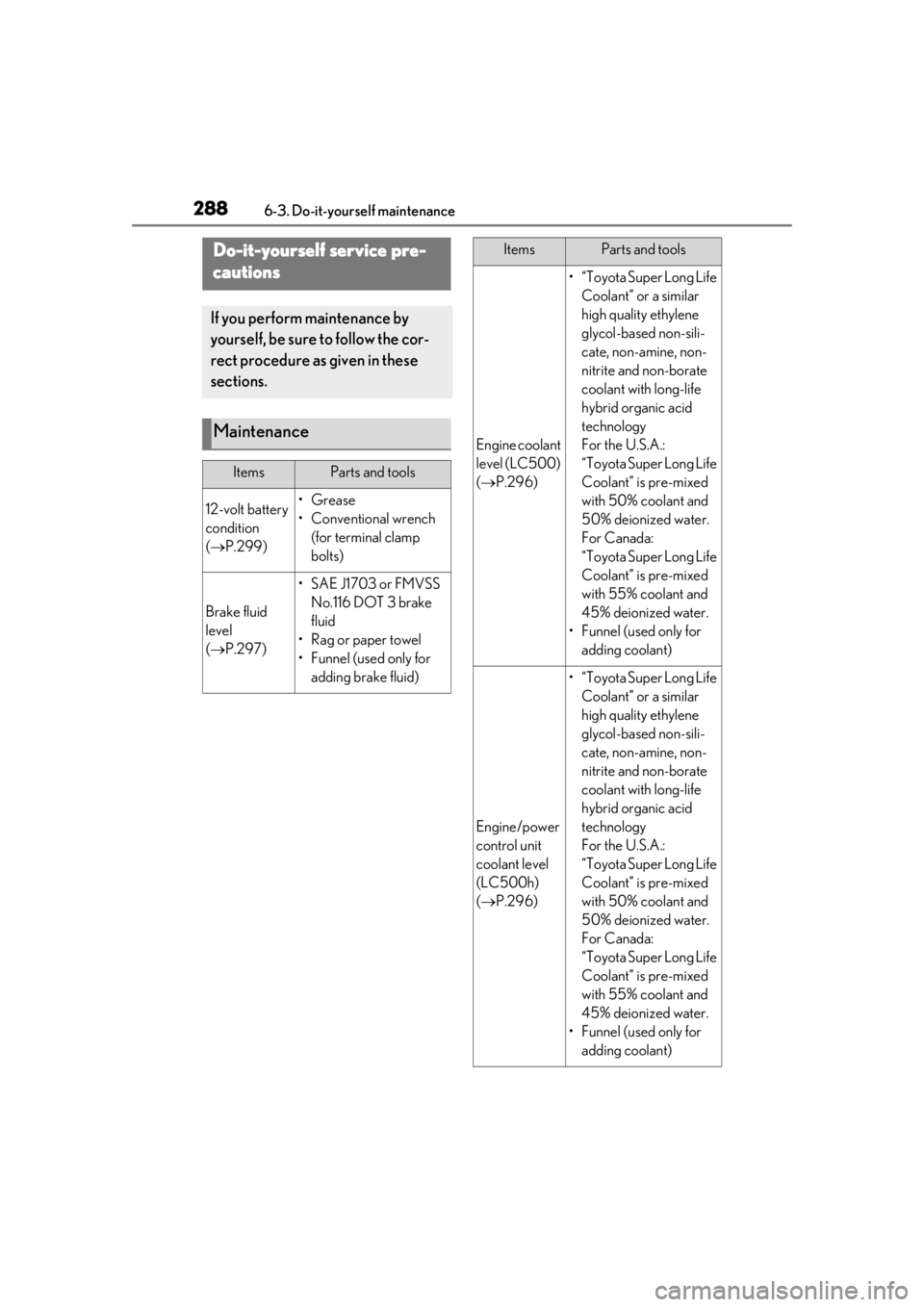
2886-3. Do-it-yourself maintenance
6-3.Do-it-yourself maintenance
Do-it-yourself service pre-
cautions
If you perform maintenance by
yourself, be sure to follow the cor-
rect procedure as given in these
sections.
Maintenance
ItemsParts and tools
12-volt battery
condition
( P.299)•Grease
• Conventional wrench
(for terminal clamp
bolts)
Brake fluid
level
( P.297)
• SAE J1703 or FMVSS
No.116 DOT 3 brake
fluid
• Rag or paper towel
• Funnel (used only for adding brake fluid)
Engine coolant
level (LC500)
( P.296)
•“Toyota Super Long Life
Coolant” or a similar
high quality ethylene
glycol-based non-sili-
cate, non-amine, non-
nitrite and non-borate
coolant with long-life
hybrid organic acid
technology
For the U.S.A.:
“Toyota Super Long Life
Coolant” is pre-mixed
with 50% coolant and
50% deionized water.
For Canada:
“Toyota Super Long Life
Coolant” is pre-mixed
with 55% coolant and
45% deionized water.
• Funnel (used only for adding coolant)
Engine/power
control unit
coolant level
(LC500h)
( P.296)
•“Toyota Super Long Life
Coolant” or a similar
high quality ethylene
glycol-based non-sili-
cate, non-amine, non-
nitrite and non-borate
coolant with long-life
hybrid organic acid
technology
For the U.S.A.:
“Toyota Super Long Life
Coolant” is pre-mixed
with 50% coolant and
50% deionized water.
For Canada:
“Toyota Super Long Life
Coolant” is pre-mixed
with 55% coolant and
45% deionized water.
• Funnel (used only for adding coolant)
ItemsParts and tools
Page 289 of 432
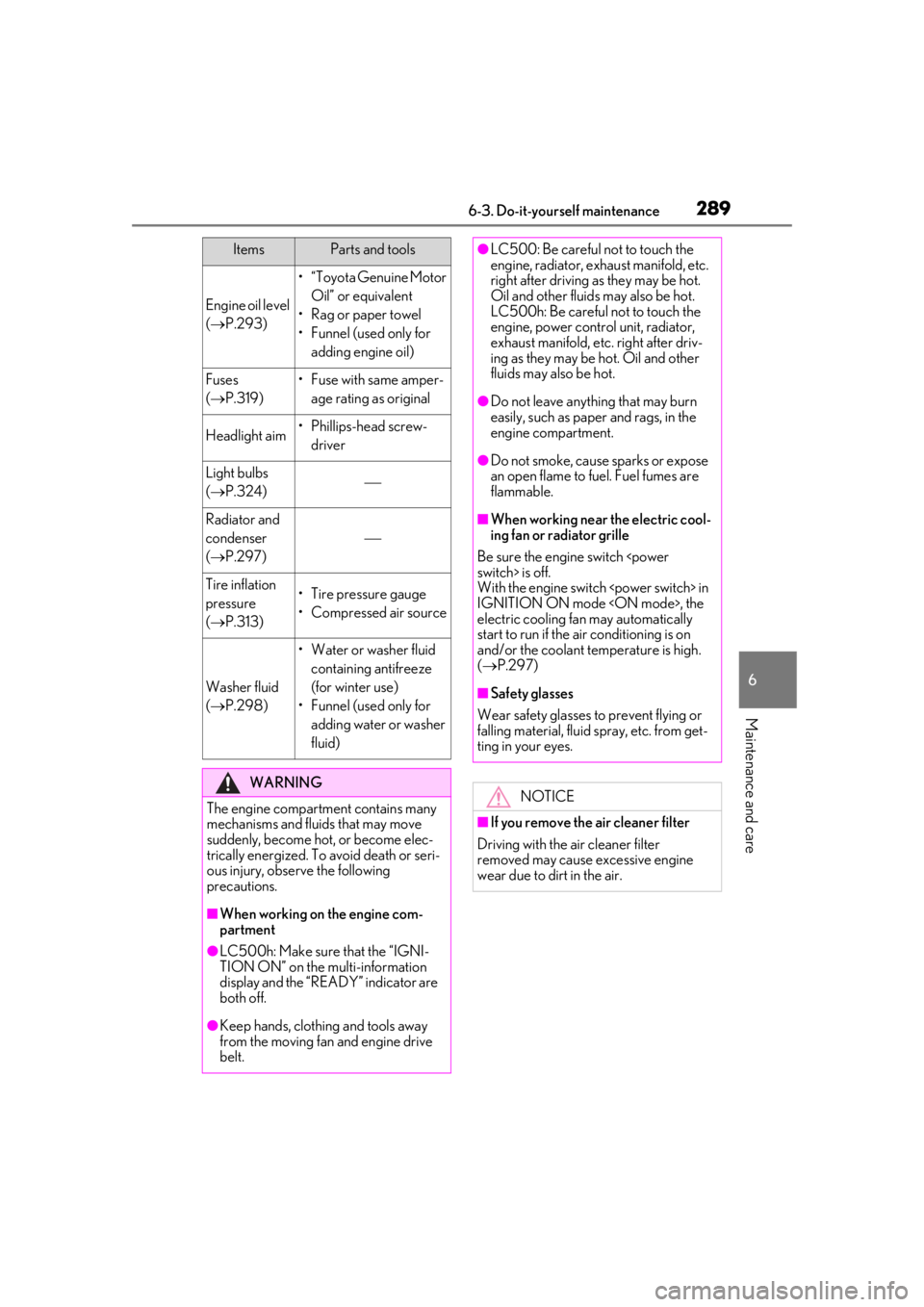
2896-3. Do-it-yourself maintenance
6
Maintenance and care
Engine oil level
( P.293)
• “Toyota Genuine Motor
Oil” or equivalent
• Rag or paper towel
• Funnel (used only for adding engine oil)
Fuses
( P.319)•Fuse with same amper-
age rating as original
Headlight aim• Phillips-head screw-driver
Light bulbs
( P.324)
Radiator and
condenser
( P.297)
Tire inflation
pressure
( P.313)• Tire pressure gauge
• Compressed air source
Washer fluid
( P.298)
• Water or washer fluid
containing antifreeze
(for winter use)
• Funnel (used only for adding water or washer
fluid)
WARNING
The engine compartment contains many
mechanisms and fluids that may move
suddenly, become hot, or become elec-
trically energized. To avoid death or seri-
ous injury, observe the following
precautions.
■When working on the engine com-
partment
●LC500h: Make sure that the “IGNI-
TION ON” on the multi-information
display and the “READY” indicator are
both off.
●Keep hands, clothi ng and tools away
from the moving fan and engine drive
belt.
ItemsParts and tools●LC500: Be careful not to touch the
engine, radiator, exhaust manifold, etc.
right after driving as they may be hot.
Oil and other fluids may also be hot.
LC500h: Be careful not to touch the
engine, power control unit, radiator,
exhaust manifold, etc. right after driv-
ing as they may be hot. Oil and other
fluids may also be hot.
●Do not leave anything that may burn
easily, such as paper and rags, in the
engine compartment.
●Do not smoke, cause sparks or expose
an open flame to fuel. Fuel fumes are
flammable.
■When working near the electric cool-
ing fan or radiator grille
Be sure the engine switch
With the engine switch
IGNITION ON mode
electric cooling fan may automatically
start to run if the air conditioning is on
and/or the coolant temperature is high.
( P.297)
■Safety glasses
Wear safety glasses to prevent flying or
falling material, fluid spray, etc. from get-
ting in your eyes.
NOTICE
■If you remove the air cleaner filter
Driving with the air cleaner filter
removed may cause excessive engine
wear due to dirt in the air.
Page 304 of 432
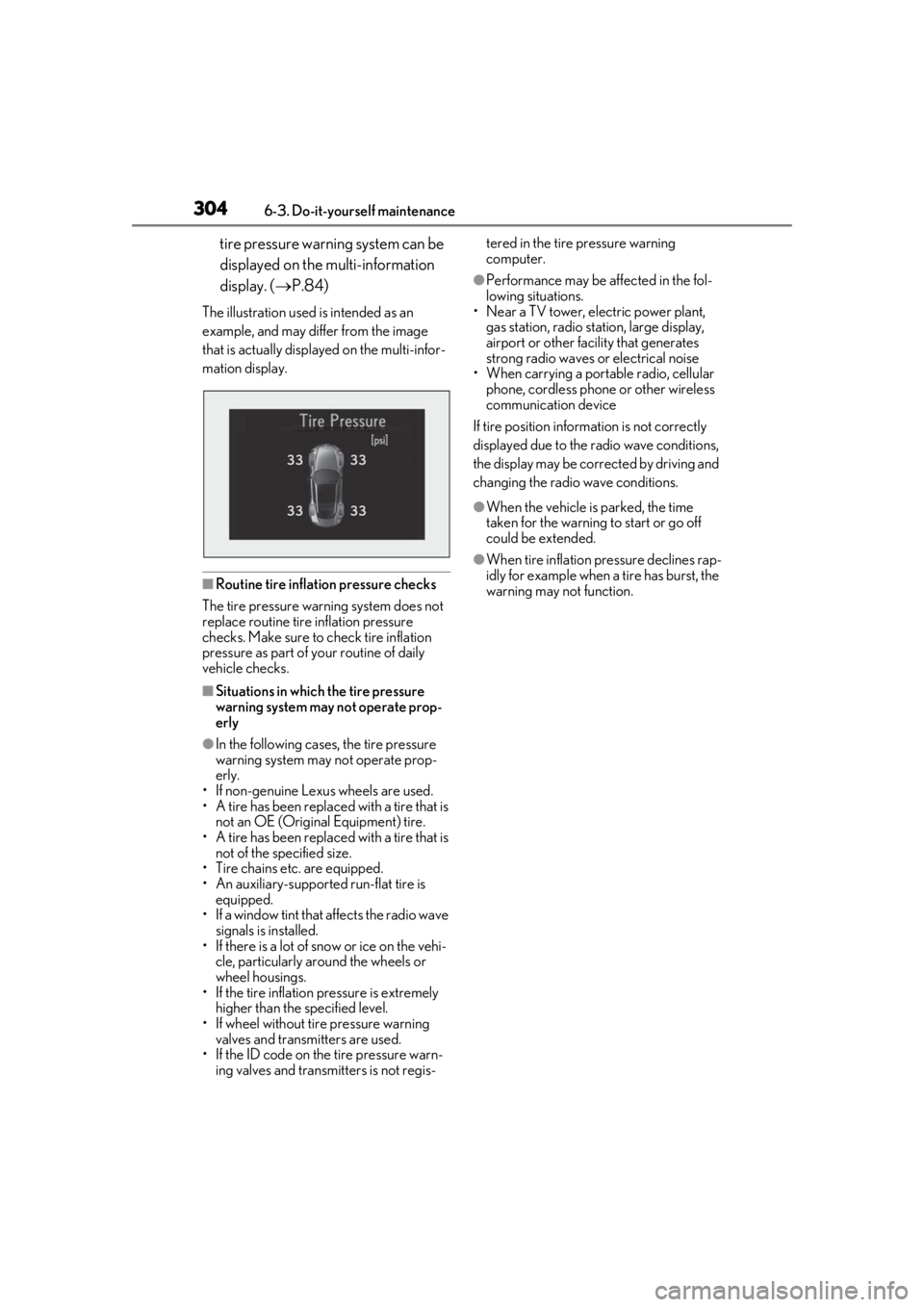
3046-3. Do-it-yourself maintenance
tire pressure warning system can be
displayed on the multi-information
display. (P.84)
The illustration used is intended as an
example, and may differ from the image
that is actually displayed on the multi-infor-
mation display.
■Routine tire inflation pressure checks
The tire pressure warning system does not
replace routine tire inflation pressure
checks. Make sure to check tire inflation
pressure as part of your routine of daily
vehicle checks.
■Situations in which the tire pressure
warning system may not operate prop-
erly
●In the following cases, the tire pressure
warning system may not operate prop-
erly.
• If non-genuine Lexus wheels are used.
• A tire has been replaced with a tire that is
not an OE (Original Equipment) tire.
• A tire has been replaced with a tire that is
not of the specified size.
• Tire chains etc. are equipped.
• An auxiliary-supported run-flat tire is equipped.
• If a window tint that affects the radio wave signals is installed.
• If there is a lot of snow or ice on the vehi- cle, particularly around the wheels or
wheel housings.
• If the tire inflation pressure is extremely higher than the specified level.
• If wheel without tire pressure warning valves and transmitters are used.
• If the ID code on the tire pressure warn-
ing valves and transmitters is not regis- tered in the tire pressure warning
computer.
●Performance may be af
fected in the fol-
lowing situations.
• Near a TV tower, electric power plant,
gas station, radio stat ion, large display,
airport or other fac ility that generates
strong radio waves or electrical noise
• When carrying a portable radio, cellular phone, cordless phone or other wireless
communication device
If tire position information is not correctly
displayed due to the radio wave conditions,
the display may be corrected by driving and
changing the radio wave conditions.
●When the vehicle is parked, the time
taken for the warning to start or go off
could be extended.
●When tire inflation pr essure declines rap-
idly for example when a tire has burst, the
warning may not function.
Page 310 of 432
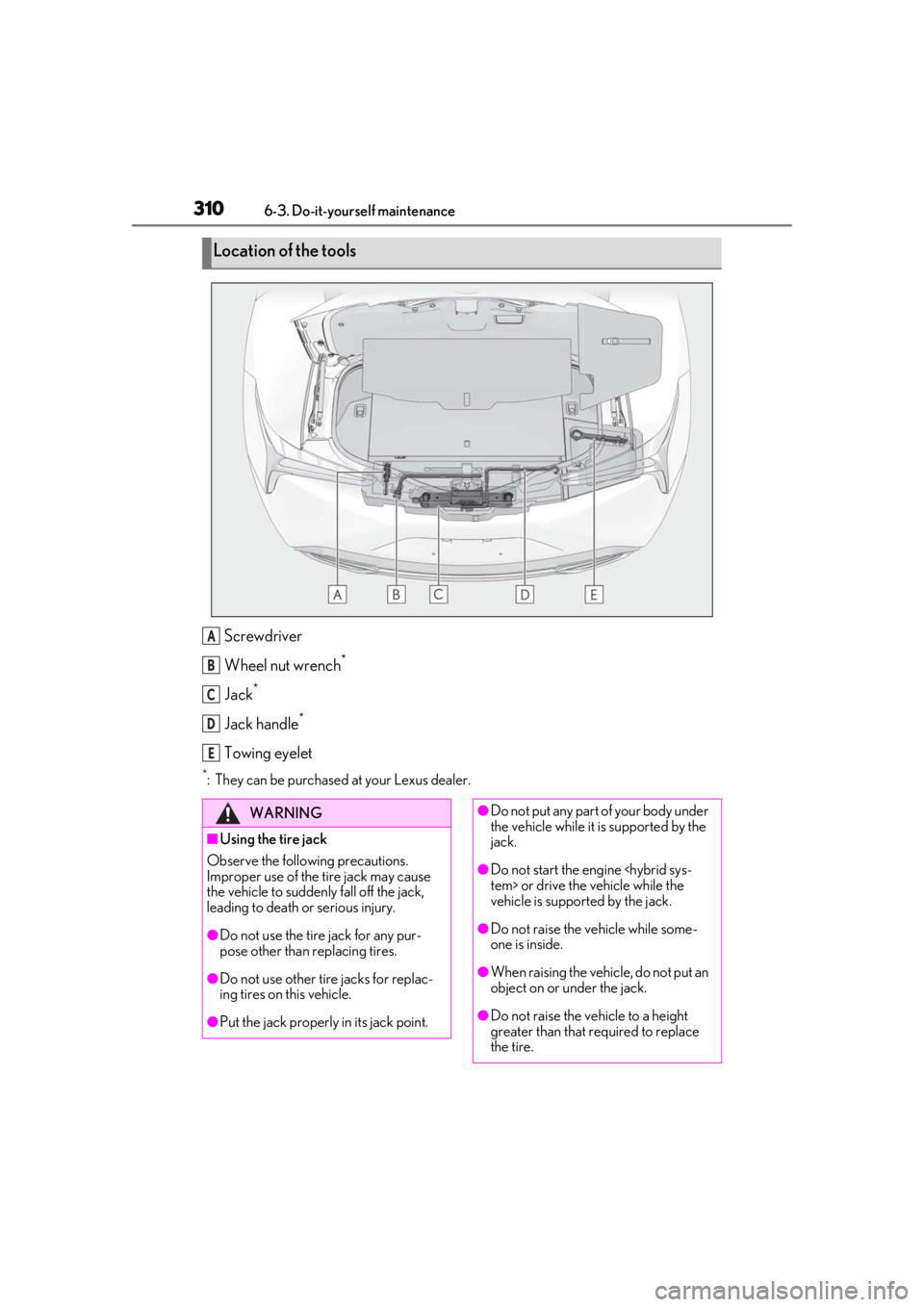
3106-3. Do-it-yourself maintenance
Screwdriver
Wheel nut wrench
*
Jack*
Jack handle*
Towing eyelet
*: They can be purchased at your Lexus dealer.
Location of the tools
A
B
C
D
E
WARNING
■Using the tire jack
Observe the following precautions.
Improper use of the tire jack may cause
the vehicle to suddenly fall off the jack,
leading to death or serious injury.
●Do not use the tire jack for any pur-
pose other than replacing tires.
●Do not use other tire jacks for replac-
ing tires on this vehicle.
●Put the jack properly in its jack point.
●Do not put any part of your body under
the vehicle while it is supported by the
jack.
●Do not start the engine
vehicle is supported by the jack.
●Do not raise the vehicle while some-
one is inside.
●When raising the vehicle, do not put an
object on or under the jack.
●Do not raise the vehicle to a height
greater than that required to replace
the tire.
Page 312 of 432
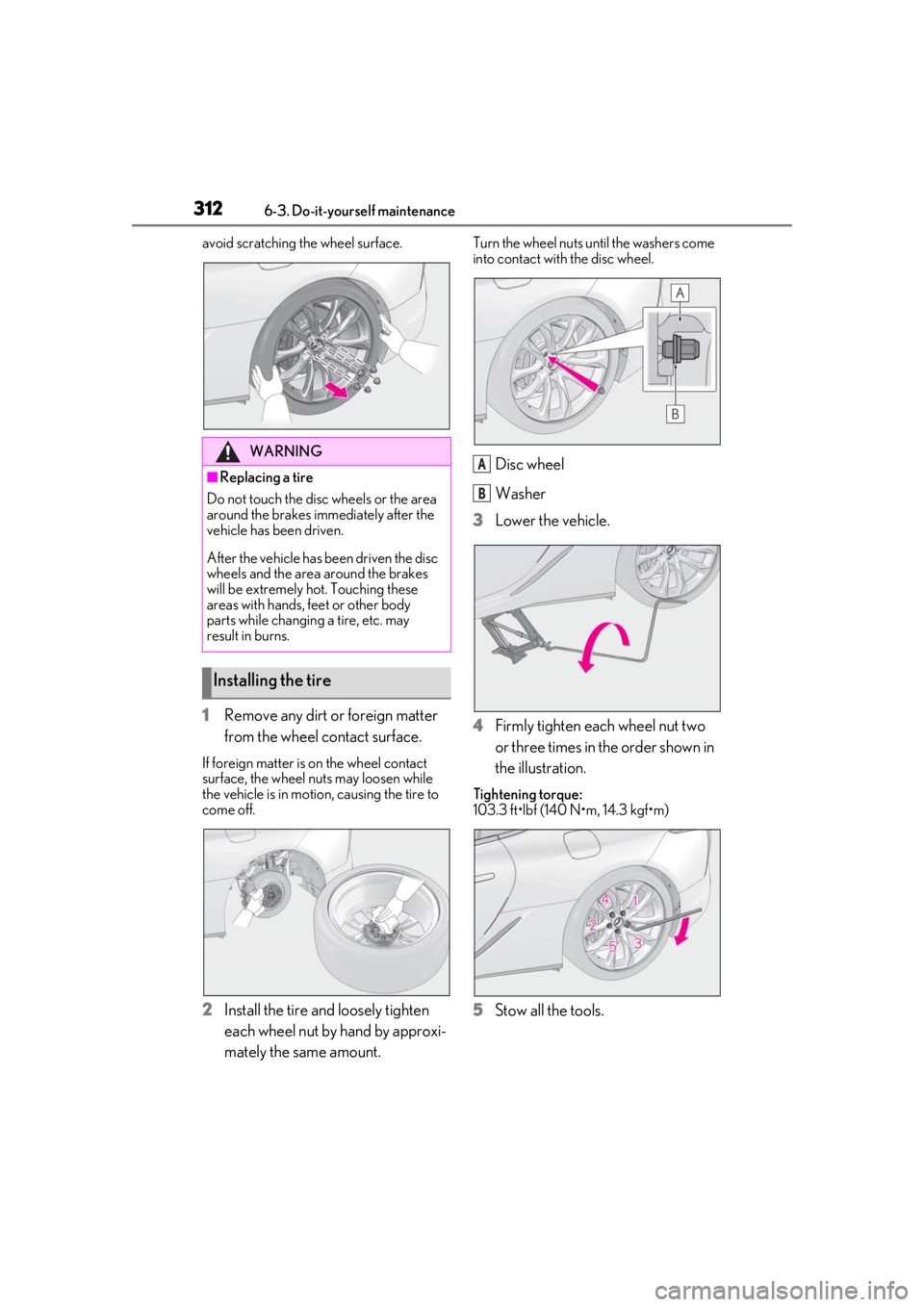
3126-3. Do-it-yourself maintenance
avoid scratching the wheel surface.
1Remove any dirt or foreign matter
from the wheel contact surface.
If foreign matter is on the wheel contact
surface, the wheel nuts may loosen while
the vehicle is in motion, causing the tire to
come off.
2Install the tire and loosely tighten
each wheel nut by hand by approxi-
mately the same amount.
Turn the wheel nuts until the washers come
into contact with the disc wheel.
Disc wheel
Washer
3 Lower the vehicle.
4 Firmly tighten each wheel nut two
or three times in the order shown in
the illustration.
Tightening torque:
103.3 ft•lbf (140 N•m, 14.3 kgf•m)
5Stow all the tools.
WARNING
■Replacing a tire
Do not touch the disc wheels or the area
around the brakes immediately after the
vehicle has been driven.
After the vehicle has been driven the disc
wheels and the area around the brakes
will be extremely hot. Touching these
areas with hands, feet or other body
parts while changing a tire, etc. may
result in burns.
Installing the tire
A
B
Page 325 of 432
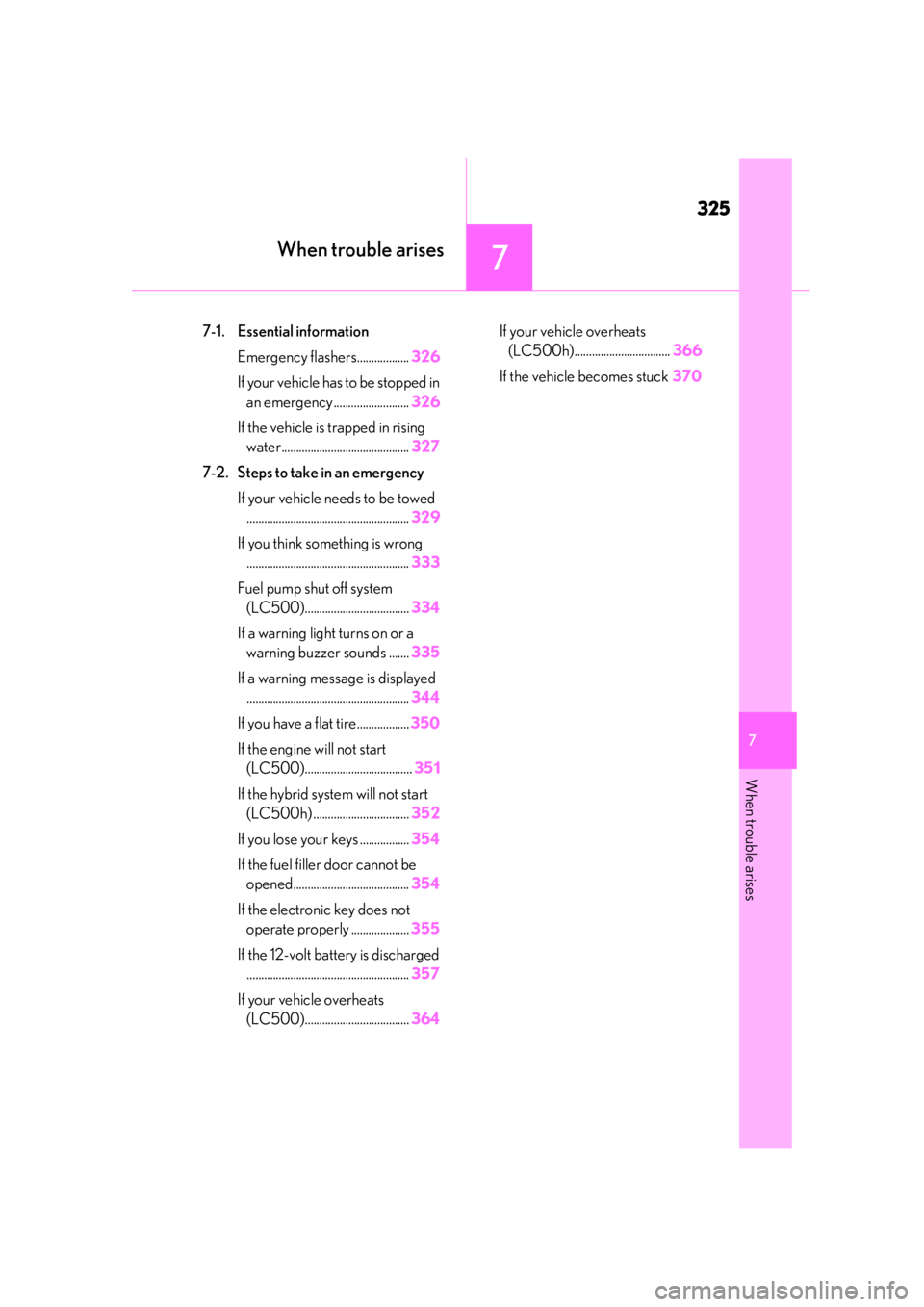
325
7
7
When trouble arises
When trouble arises
7-1. Essential informationEmergency flashers.................. 326
If your vehicle has to be stopped in an emergency .......................... 326
If the vehicle is trapped in rising water............................................ 327
7-2. Steps to take in an emergency If your vehicle needs to be towed........................................................ 329
If you think something is wrong ........................................................ 333
Fuel pump shut off system (LC500).................................... 334
If a warning light turns on or a warning buzzer sounds ....... 335
If a warning message is displayed ........................................................ 344
If you have a flat tire.................. 350
If the engine will not start (LC500)..................................... 351
If the hybrid system will not start (LC500h) ................................. 352
If you lose your keys ................. 354
If the fuel filler door cannot be opened........................................ 354
If the electronic key does not operate properly .................... 355
If the 12-volt battery is discharged ........................................................ 357
If your vehicle overheats (LC500).................................... 364If your vehicle overheats
(LC500h)................................. 366
If the vehicle becomes stuck 370
Page 329 of 432
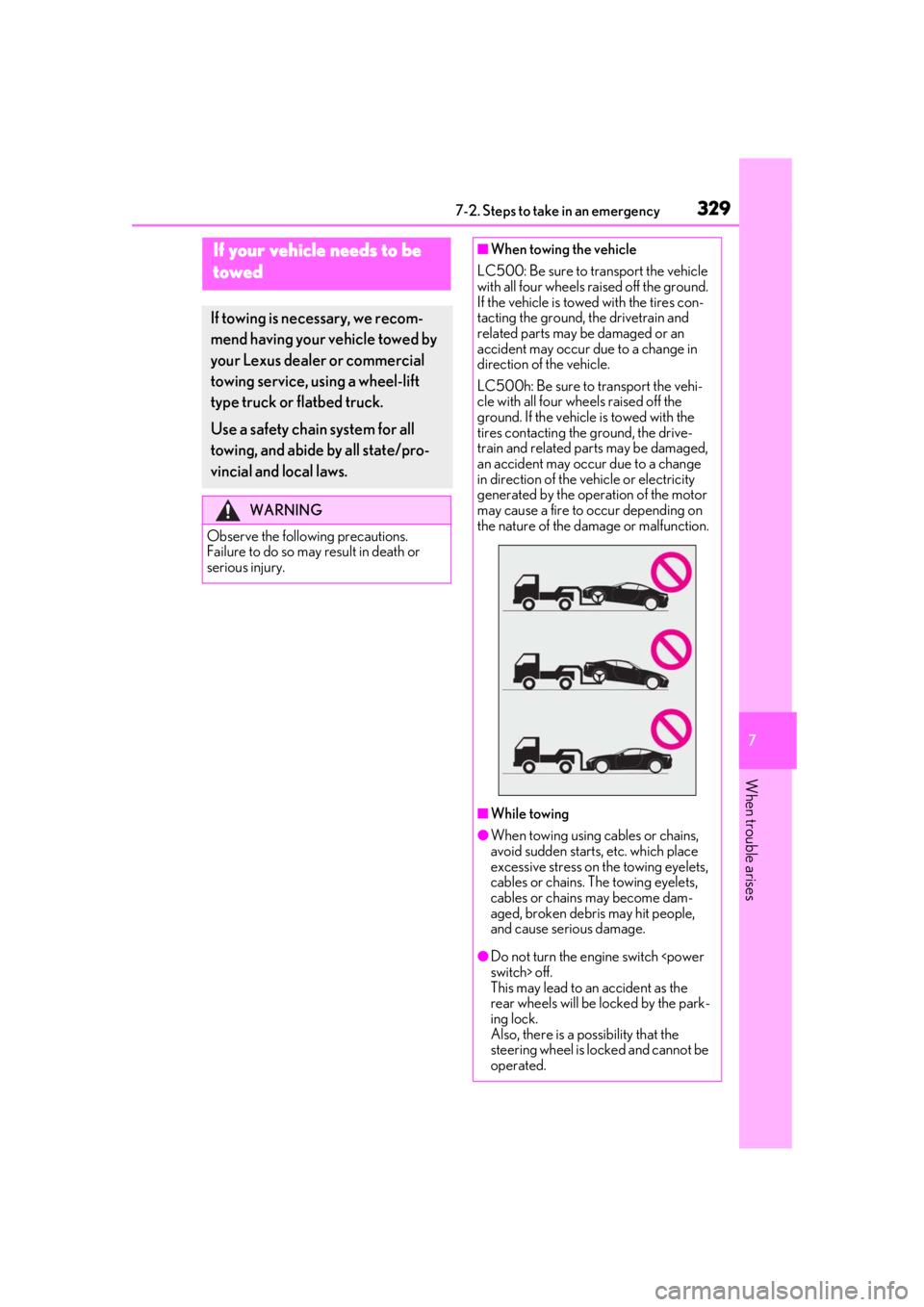
3297-2. Steps to take in an emergency
7
When trouble arises
7-2.Steps to take in an emergency
If your vehicle needs to be
towed
If towing is necessary, we recom-
mend having your vehicle towed by
your Lexus dealer or commercial
towing service, using a wheel-lift
type truck or flatbed truck.
Use a safety chain system for all
towing, and abide by all state/pro-
vincial and local laws.
WARNING
Observe the following precautions.
Failure to do so may result in death or
serious injury.
■When towing the vehicle
LC500: Be sure to transport the vehicle
with all four wheels raised off the ground.
If the vehicle is towed with the tires con-
tacting the ground, the drivetrain and
related parts may be damaged or an
accident may occur due to a change in
direction of the vehicle.
LC500h: Be sure to transport the vehi-
cle with all four wheels raised off the
ground. If the vehicle is towed with the
tires contacting the ground, the drive-
train and related parts may be damaged,
an accident may occur due to a change
in direction of the vehicle or electricity
generated by the operation of the motor
may cause a fire to occur depending on
the nature of the damage or malfunction.
■While towing
●When towing using cables or chains,
avoid sudden starts, etc. which place
excessive stress on the towing eyelets,
cables or chains. The towing eyelets,
cables or chains may become dam-
aged, broken debris may hit people,
and cause serious damage.
●Do not turn the engine switch
This may lead to an accident as the
rear wheels will be locked by the park-
ing lock.
Also, there is a possibility that the
steering wheel is locked and cannot be
operated.
Page 330 of 432
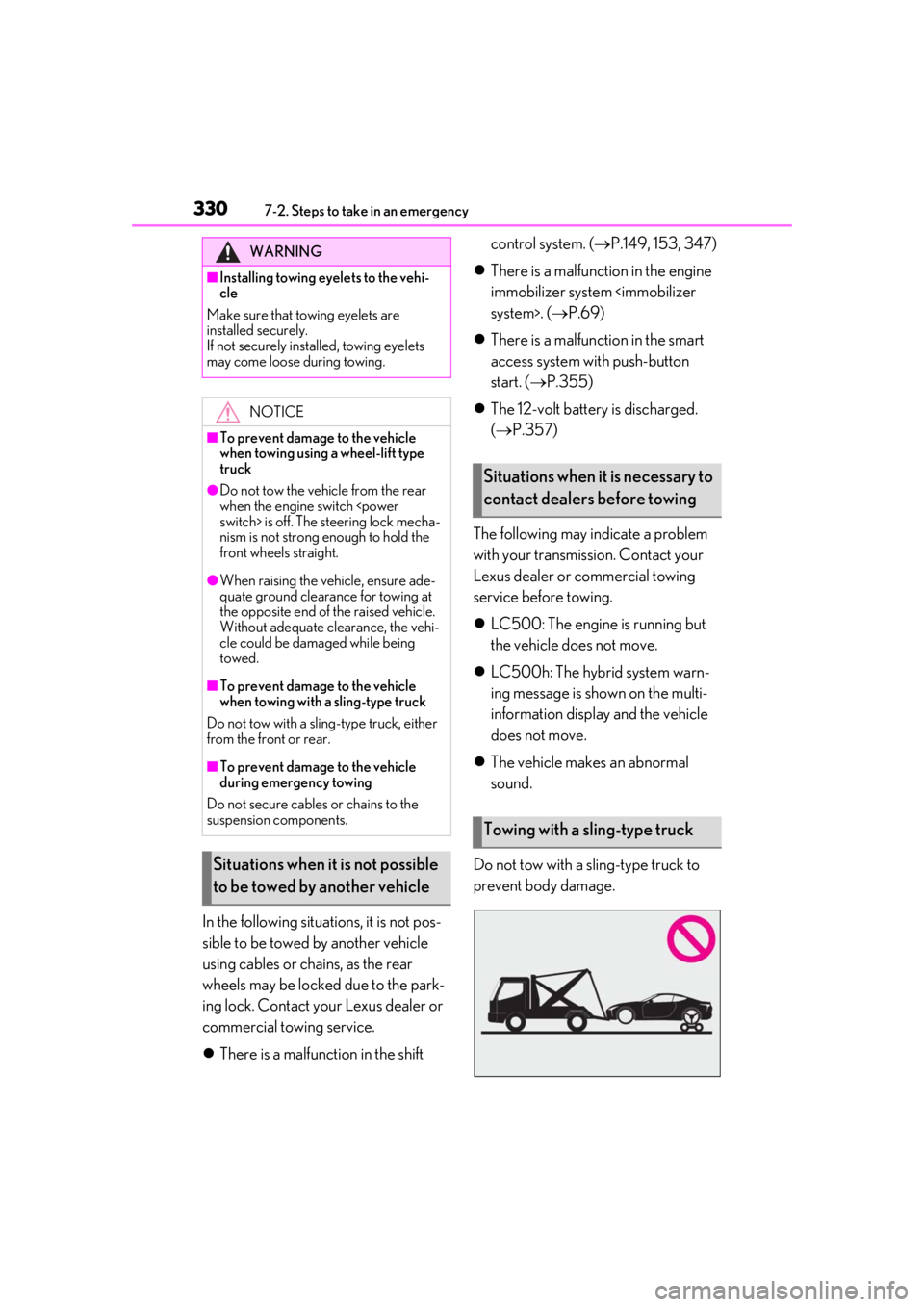
3307-2. Steps to take in an emergency
In the following situations, it is not pos-
sible to be towed by another vehicle
using cables or chains, as the rear
wheels may be locked due to the park-
ing lock. Contact your Lexus dealer or
commercial towing service.
There is a malfunction in the shift control system. (
P.149, 153, 347)
There is a malfunction in the engine
immobilizer system
There is a malfunction in the smart
access system with push-button
start. ( P.355)
The 12-volt battery is discharged.
( P.357)
The following may indicate a problem
with your transmission. Contact your
Lexus dealer or commercial towing
service before towing.
LC500: The engine is running but
the vehicle does not move.
LC500h: The hybrid system warn-
ing message is shown on the multi-
information display and the vehicle
does not move.
The vehicle makes an abnormal
sound.
Do not tow with a sling-type truck to
prevent body damage.
WARNING
■Installing towing eyelets to the vehi-
cle
Make sure that towing eyelets are
installed securely.
If not securely installed, towing eyelets
may come loose during towing.
NOTICE
■To prevent damage to the vehicle
when towing using a wheel-lift type
truck
●Do not tow the vehicle from the rear
when the engine switch
nism is not strong enough to hold the
front wheels straight.
●When raising the vehicle, ensure ade-
quate ground clearance for towing at
the opposite end of the raised vehicle.
Without adequate clearance, the vehi-
cle could be damaged while being
towed.
■To prevent damage to the vehicle
when towing with a sling-type truck
Do not tow with a sling-type truck, either
from the front or rear.
■To prevent damage to the vehicle
during emergency towing
Do not secure cables or chains to the
suspension components.
Situations when it is not possible
to be towed by another vehicle
Situations when it is necessary to
contact dealers before towing
Towing with a sling-type truck